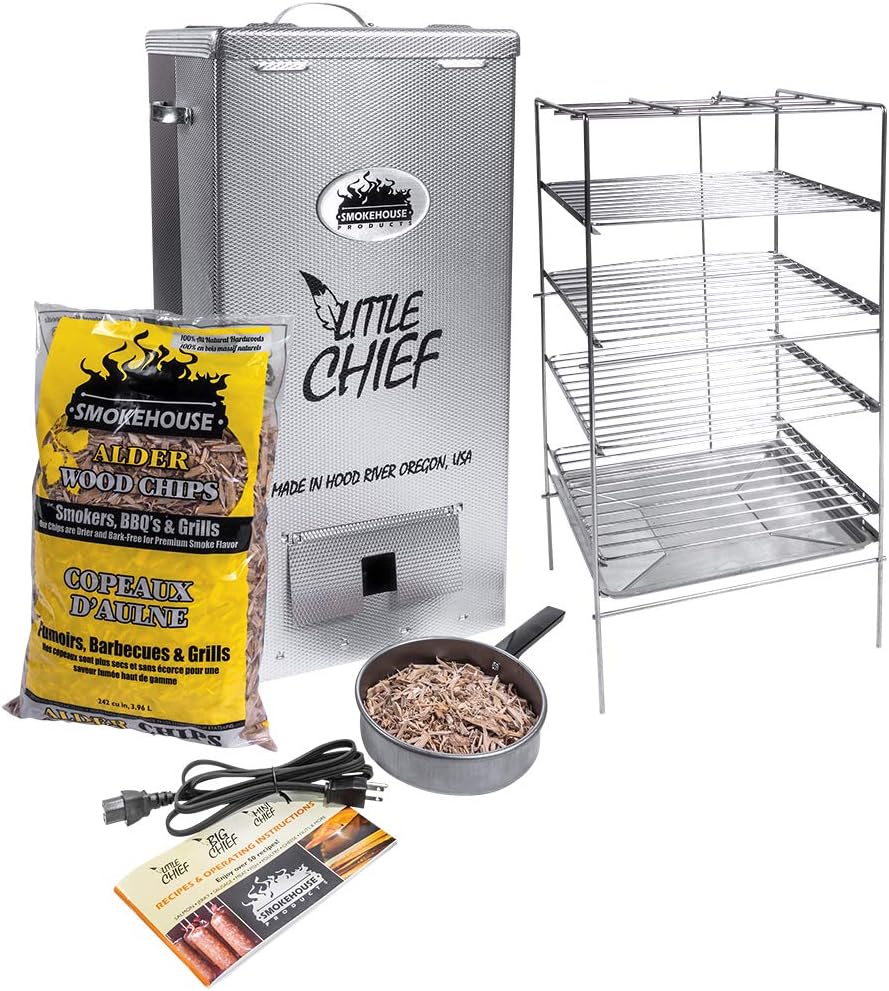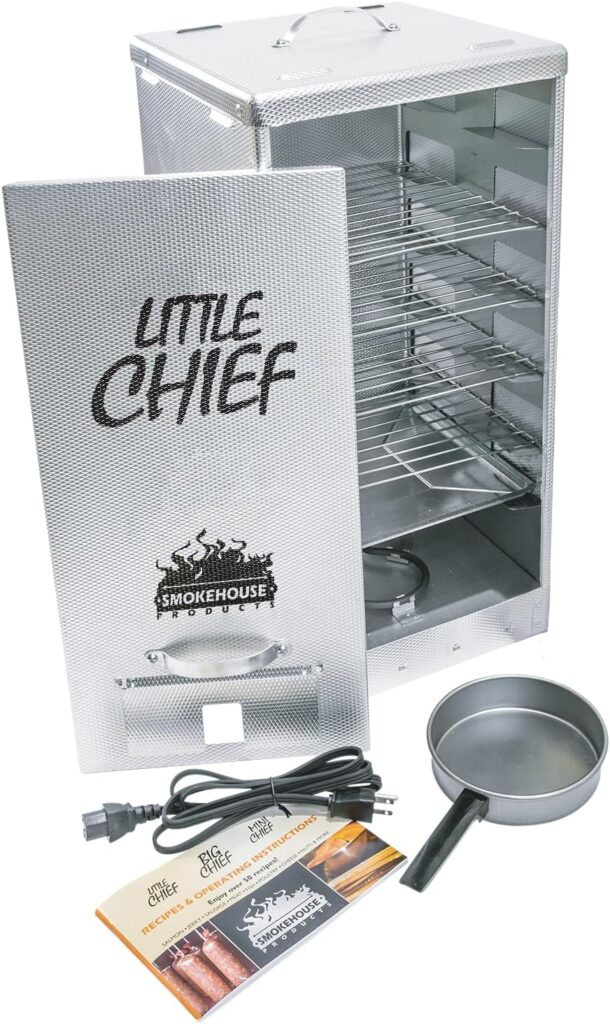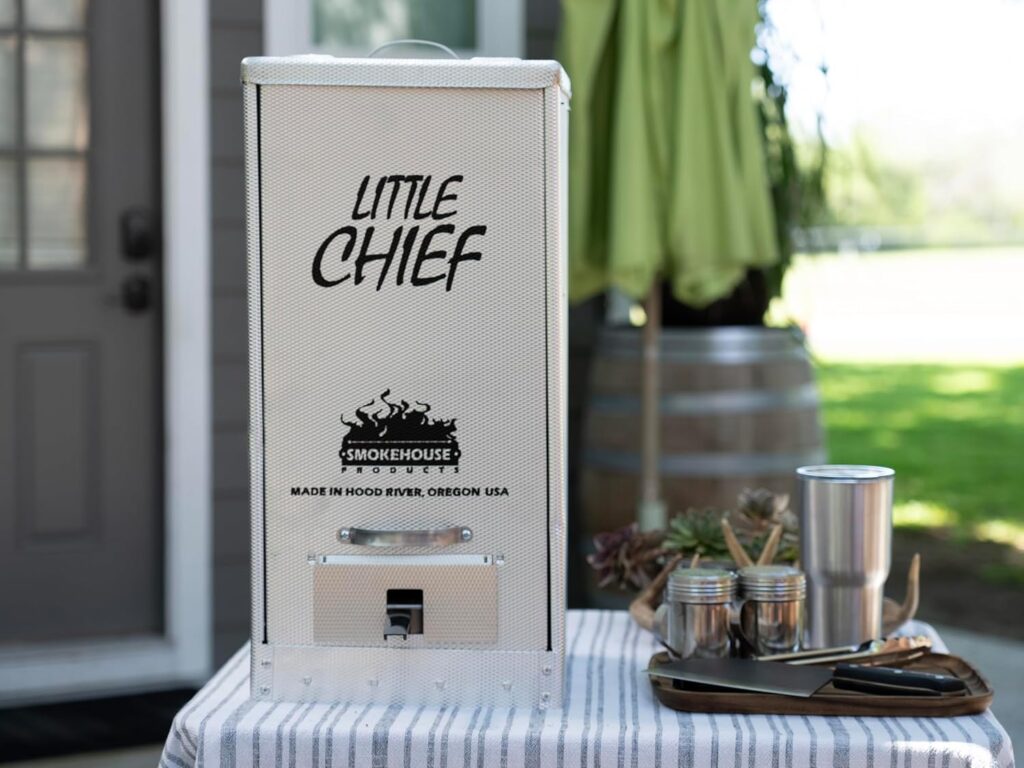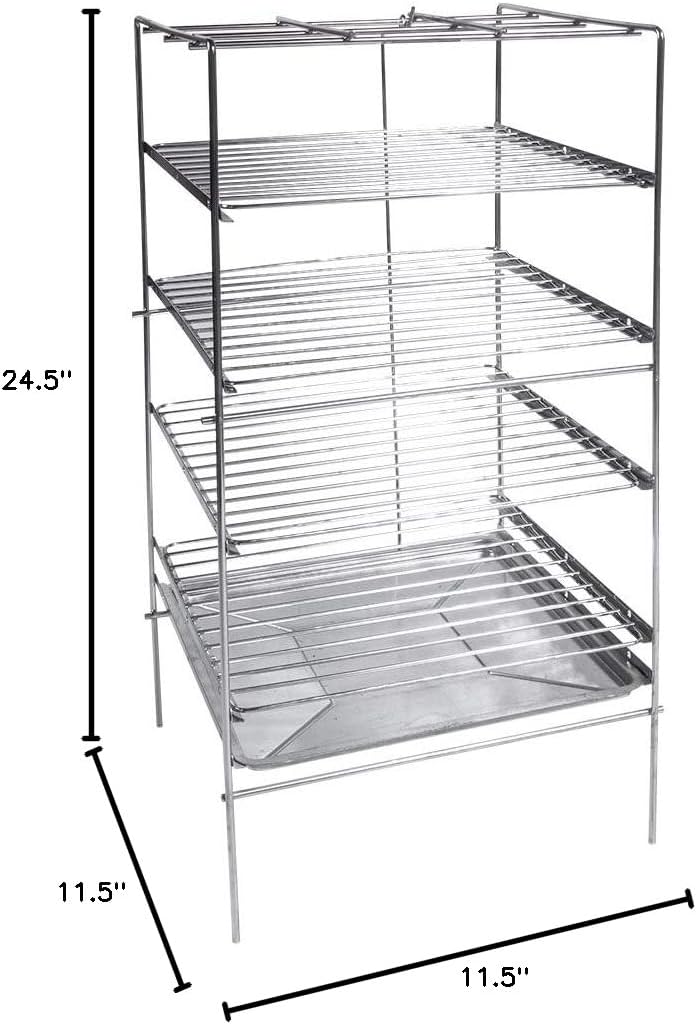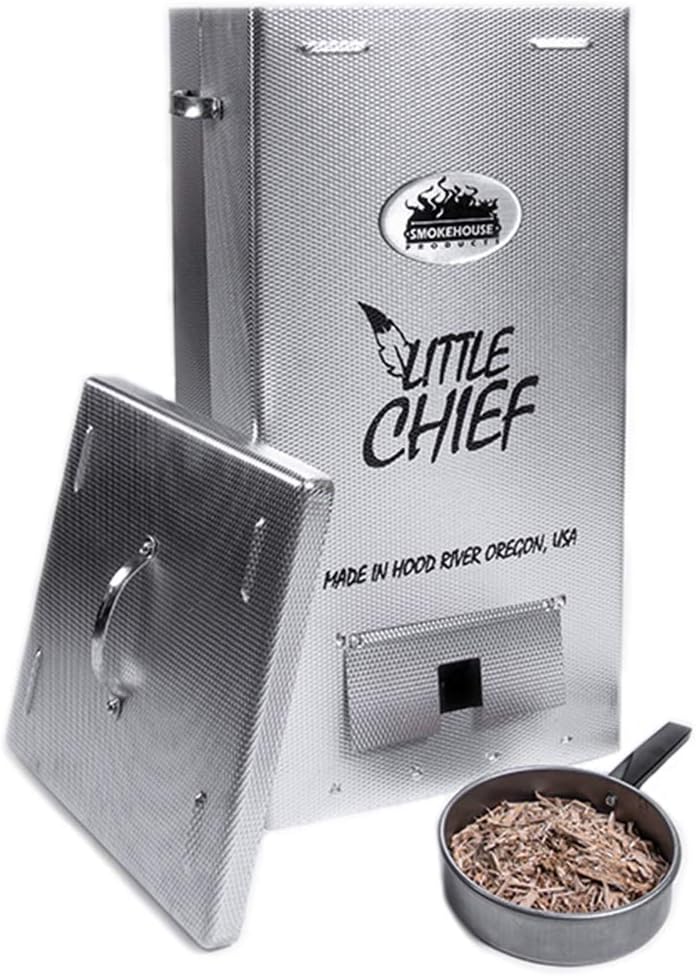?Are you wondering if the Smokehouse Little Chief Front Load Smoker is the right choice for your low-temperature smoking needs?
This image is property of Amazon.com.
Quick summary
You’ll find the Smokehouse Little Chief Front Load Smoker is a purpose-built, low-temperature electric smoker designed for smoking fish, jerky, cheese, sausage, and similar foods. It keeps things simple: steady heat around 165°F, a removable wood chip pan, room for up to 25 pounds of product, and plug-and-play operation with no wireless fuss.
Smokehouse Little Chief Front Load Smoker, Low to Mid Temperature Smoker for Fish, Jerky, Cheese, Sausage & Other meats, Smoke Up to 25 Pounds of Meat & Fish
What the Smokehouse Little Chief Is
This unit is an electric front-load smoker aimed at maintaining a consistent low temperature for delicate smoking tasks. You get a compact, reliable appliance that focuses on achieving steady smoke at a single, ideal low temperature instead of juggling multiple temperature ranges or digital features.
Key specifications
Below you’ll see the main features summarized so you can quickly understand what the smoker offers and how it will fit into your setup. These specs emphasize the smoker’s strengths: low, steady temperature, simple electric operation, and solid smoking capacity.
| Feature | What it is | Why it matters to you |
|---|---|---|
| Model | Smokehouse Little Chief Front Load Smoker | Recognized, long-running model from a trusted brand |
| Temperature | Steady low temperature — about 165°F | Ideal for fish, jerky, cheese, and sausage — minimizes overcooking |
| Capacity | Up to 25 pounds of meat or fish | Allows you to smoke large batches without repeated cycles |
| Power | Standard household outlet (plug-in electric) | No special power setup required; easy indoor/outdoor use where permitted |
| Operation | Simple on/off electric control, front-load door | Easy to use, no apps or complex controls to manage |
| Wood chip pan | Removable from outside without opening main door | Keeps heat steady during chip changes and limits temperature fluctuation |
| Use cases | Fish, jerky, cheese, sausage, some meats | Optimized for low-temp smoking and curing-style applications |
| Heritage | Smokehouse brand since 1968 | Legacy brand with history of salmon/trout smoking |
Performance and temperature control
You’ll get a very consistent low-temperature environment designed to sit near 165°F, which is the most notable performance characteristic of this smoker. That single-temperature approach makes the Little Chief excellent for specific smoking tasks but means you won’t be able to run high-temperature barbecue sessions in the same unit.
Smoking quality
When you use proper brining, adequate wood chips, and the correct smoking times, the smoker produces excellent aroma and surface smoke ring on fish and jerky. You’ll notice a clear, focused smoke flavor rather than aggressive char or strong creosote, provided you manage wood-chip quantity and quality.
Heat consistency and stability
The Little Chief is built to hold that low temperature without wide swings, which is particularly helpful for cheese and jerky where temperature excursions can ruin texture. The removable chip pan design helps you maintain consistent heat even when you need to refresh chips, because you don’t have to open the main door and lose heat.
Capacity and usability
You can smoke up to 25 pounds of product at a time, which makes the Little Chief practical for batch cooking, preserving, or preparing multiple portions at once. If you prepare jerky for a crowd or smoke several fillets of salmon, you’ll appreciate not having to do repeated small batches.
Racks and loading
The front-load design makes it straightforward to slide full racks in and out, and the internal spacing is optimized for thin or flat items like fillets and strips. You’ll want to arrange items in a single layer or evenly spaced so smoke circulates freely and the product dries and smokes evenly.
Cleaning and maintenance
Cleaning is straightforward: the drip pan and the removable wood chip pan are accessible and simple to empty, and the stainless-ish interior surfaces wipe down without much elbow grease if you address spills soon after use. You should plan on a routine cleaning after every few uses to prevent buildup of grease or sticky residue that can affect flavor.
Removing wood chips and reloading
Because the wood chip pan pulls out without opening the primary smoking chamber, you can add chips mid-run without causing a big temperature drop. You should still be mindful of how often you add chips to avoid oversmoking; a little at a time is typically all you need.
This image is property of Amazon.com.
Operation: How you use it
Using the smoker is intentionally simple: plug it into a standard outlet, fill the chip pan, place your prepared food on the racks, and switch it on. You won’t need to fuss with thermostats, apps, or timers, so once you get comfortable with times for different foods, operation becomes almost routine.
Preparing food (brining, jerky)
You’ll get the best results if you brine or cure your fish and meats appropriately before smoking — this helps with flavor, moisture retention, and food safety. For jerky, marinate and pat strips dry so they can dehydrate and soak up smoke evenly; for fish, a short brine and gentle drying period before smoke will give the best texture.
Recommended wood chips and flavors
You’ll want to choose mild, clean-burning chips like alder, apple, cherry, or maple for delicate proteins such as salmon or whitefish, while stronger woods like hickory can overwhelm lighter foods. Because the Little Chief uses a chip pan, avoid large chunks that might smolder and produce harsh smoke; small, well-seasoned chips offer the most consistent and pleasant results.
Pros and cons
This section helps you weigh the practical advantages and limitations you’ll encounter with the Little Chief. The smoker is tailored to a particular range of tasks, and those strengths are also what create its trade-offs.
Pros
You’ll appreciate several things about the Little Chief: it’s simple to operate, holds a steady low temperature ideal for delicate smoking, and offers a respectable capacity for batch smoking. Because it’s electric and plugs into a household outlet, you don’t need special fuels or advanced setup, making it accessible for beginners and reliable for experienced users.
- Simple plug-and-play operation; minimal learning curve.
- Stable, consistent 165°F temperature — excellent for fish, jerky, and cheese.
- Removable chip pan allows chip changes without opening main door.
- Generous capacity up to 25 pounds for batch smoking.
- Longstanding brand history gives confidence in design and durability.
Cons
You’ll face limitations if you want to do a wide range of smoking styles — the Little Chief’s single low-temperature setting means you can’t run high-temp barbecue, hot smoking of large cuts, or certain types of roasting. Also, if you prefer precise digital control or remote monitoring, you’ll miss features like Wi-Fi or Bluetooth.
- Fixed low temperature limits versatility for high-temp smoking.
- No digital controls, timers, or remote monitoring.
- Not designed for heavy searing or high-heat cooking tasks.
- If you want very smoky, thick bark-like results on big cuts, this might not be the right tool.
This image is property of Amazon.com.
Comparison with other smokers
If you’re thinking about alternatives, the Little Chief stands out as a specialist in low-temp smoking rather than as an all-purpose smoker. You’ll find it competes best with similar small, low-temp electric smokers and serves as a complementary tool to full-size barbecues when you want delicate, controlled smoke.
How it compares to the Smokehouse Big Chief
The Big Chief is built for larger scale commercial or heavy-duty home use and often handles bigger volumes and more rugged applications. You’ll find the Little Chief more compact and specifically tuned to delicate jobs where temperature precision is more important than raw capacity or high output.
How it compares to other electric smokers
Compared to feature-rich modern electric smokers with multiple temperature settings and Wi-Fi connectivity, the Little Chief chooses simplicity and reliability over bells and whistles. You’ll prefer it if you value a steady low-temperature environment and minimal setup, while other electric smokers might appeal if you want multi-temp flexibility and app control.
Who should buy this
You should consider the Little Chief if you primarily smoke fish, make jerky, cure and smoke cheeses, or smoke sausages and you want a dependable, simple, low-temperature smoker. You’ll also appreciate it if you often prepare larger batches and prefer a hands-off experience without digital complexity.
This image is property of Amazon.com.
Who should not buy this
You shouldn’t pick the Little Chief if your goal is to smoke large beef briskets or pork shoulders at high temperatures for long, traditional barbecue sessions. If you want wireless control, highly adjustable temperature ranges, or the ability to sear/roast, you’ll likely find its single-temp design limiting.
Best uses and recipe ideas
This smoker excels at delicate proteins and preserved-style products, so you should prioritize salmon fillets, trout, jerky strips, cheese rounds, and smoked sausages. Below are some practical use cases and starting times you can adapt based on your preferences and local conditions.
Smoking fish and salmon
You’ll get classic smoked salmon texture and flavor by brining, air-drying, and smoking at low heat for multiple hours until the flesh firms and picks up a golden color. Because the Little Chief keeps a steady low temperature, you won’t risk overcooking the fish’s delicate proteins as easily as with high-heat smokers.
Tips:
- Brine salmon for 4–8 hours depending on thickness.
- Pat dry and let a pellicle form before smoking to help smoke adherence.
- Expect several hours of smoking depending on fillet thickness and desired dryness.
Making jerky
You’ll find the Little Chief great for jerky because the low, steady heat dries meat without cooking it too quickly, helping maintain chew and flavor. Thin, uniform strips and a good marinade give the best, consistent results — think 4–8 hours as a typical window, adjusted for thickness and humidity.
Tips:
- Slice thin and evenly; marinate for at least a few hours.
- Arrange strips so air can circulate and avoid overlap.
- Check texture periodically; jerky should be dry but still slightly pliable.
Smoking cheese and sausage
For cheese, you’ll appreciate how steady low temps let smoke adhere without melting the cheese into a mess. For sausages, the Little Chief can add surface flavor and help set casing while keeping internal temperatures gentle when combined with proper curing or par-cooking as needed.
Tips:
- Use cold-smoking chips or very small amounts of wood to avoid melting cheese.
- Smoke cheese for short sessions (a few hours) and rotate to ensure even smoke exposure.
- For sausage, ensure the product is properly cured before smoking and monitor times carefully.
This image is property of Amazon.com.
Safety tips
You should always use the smoker in a well-ventilated area and follow manufacturer safety instructions for electrical appliances. Keep the smoker on a stable, heat-tolerant surface away from flammable materials, and never leave it unattended for extended periods without checking chips and product.
Electrical safety
You’ll want to plug the smoker into a properly rated outlet, avoid extension cords unless they’re heavy-duty and rated for the load, and protect the cord from water or physical damage. If you notice unusual smells, smoke that seems electrical in nature, or tripped breakers, unplug and inspect before continuing.
Food safety
You should follow safe curing and brining practices, and ensure that jerky and smoked fish are treated properly for microbial safety, especially if you plan to store products at room temperature. When in doubt, consult reliable food-safety guidelines for smoking and curing proteins, and refrigerate or freeze finished goods according to recommended timelines.
Troubleshooting common problems
If you encounter inconsistent flavor, excessive soot, or uneven drying, there are several straightforward troubleshooting steps you can try before assuming a hardware fault. Most issues relate to chip quantity, chip cleanliness, loading density, or not allowing a pellicle to form on fish and meats before smoking.
Common fixes:
- If smoke is too heavy or bitter, reduce chip quantity and use cleaner, well-seasoned chips.
- If drying is uneven, rearrange racks so airflow is balanced and avoid overlapping pieces.
- If temperature seems off, verify room conditions and that the unit is on a stable level surface; remember it’s designed for around 165°F, not higher.
Accessories and upgrades
You can enhance your experience by using quality wood chips, an external thermometer for double-checking internal temperatures, and non-stick racks to help with delicate items. While the Little Chief is intentionally simple, small accessories can help you get more consistent results and make cleanup easier.
Recommended accessories:
- High-quality, mild smoking chips (alder, apple, cherry).
- An external digital probe thermometer to spot-check product temps.
- Non-stick or perforated trays for small items that might fall through racks.
Maintenance schedule
You should set a simple cleaning routine: empty the chip pan and drip pan after each session, give the interior a gentle wipe monthly or after heavy use, and inspect electrical components occasionally. Replace chips with fresh, dry wood; wet or green wood produces harsher smoke and can create residue buildup.
Suggested routine:
- After each use: remove and empty chip pan and drip pan, wipe racks.
- Monthly or after heavy use: deep clean racks, interior surfaces, and check seals and door fit.
- Seasonally: inspect cord and plug for wear, check for rust or damaged components.
Tips to get the best smoke flavor
You’ll get the cleanest flavors by using well-seasoned wood chips, adding chips in small amounts to avoid choking the chamber with smoke, and by letting meats form a pellicle before smoking. Consistency in technique will produce predictable, pleasing results faster than changing many variables at once.
Practical tips:
- Use just enough chips to produce a clear, thin smoke rather than a thick white plume.
- Rotate trays during longer sessions for uniform smoking.
- Keep a log of time, wood type, and results so you can repeat successes.
Longevity and build quality
With proper care, you can expect the Little Chief to provide many seasons of dependable service because its design focuses on electrical heating and a few simple mechanical components. The lack of complex electronics often means fewer failure points, and you should be able to troubleshoot or replace consumables like racks and pans relatively easily.
What you should watch for:
- Regular cleaning prevents corrosive buildup and extends life.
- Avoiding rough handling of the door and seals ensures consistent performance.
- Keeping wood chips dry prevents clogging and reduces residue buildup.
Price-to-value assessment
You’ll likely find the Little Chief offers good value if you primarily need a low-temperature smoker for fish, jerky, and cheese, where precision and gentle heat matter more than high performance. If you expect to use it as a one-stop solution for all outdoor cooking needs, the value proposition is weaker because it’s specialized rather than universal.
Environmental and placement considerations
You should place the smoker outdoors or in a well-ventilated area where smoking is allowed, and avoid using it in enclosed spaces that accumulate smoke. Because it plugs into a household outlet, ensure your power source is appropriately rated and that the location is safe from rain and splashing water.
Common user questions (FAQs)
You’ll want straightforward answers to practical questions before you buy; below are common queries with concise answers to inform your decision.
- Q: Can you adjust the temperature?
- A: No, the Little Chief is designed to hold a steady low temperature around 165°F rather than offering adjustable temperature settings.
- Q: Can you use it indoors?
- A: The smoker is electric and plugs into a household outlet, but you should only use it indoors if you have appropriate ventilation and manufacturer guidance permits it; typically these are used outdoors or in well-ventilated areas.
- Q: How often do you add wood chips?
- A: It depends on your wood type and desired smoke intensity; small top-ups every 1–3 hours are common for prolonged sessions.
- Q: Is it good for large cuts of meat?
- A: It’s not designed for long, high-temperature smoking of large cuts; it’s ideal for low-temp applications.
Real-world user scenarios
If you’re preparing smoked gifts, curing household jerky, or making salmon for a special meal, you’ll find this unit very practical. For example, you might smoke 10–15 pounds of salmon fillets for a gathering, or batch-produce jerky strips to store for later — both are tasks that the Little Chief handles efficiently.
Scenario examples:
- Weekend project: Brine salmon Friday night, smoke Saturday morning, serve smoked filets for brunch.
- Jerky production: Marinate and slice in the afternoon, smoke in the evening, package and store the next day.
- Cheese smoking: Quick cold-smoke sessions to add flavor to rounds while keeping the cheese intact.
Final verdict
If your smoking goals are centered on fish, jerky, cheese, and sausages — and you want a simple, reliable, low-temperature electric smoker — the Smokehouse Little Chief Front Load Smoker is a strong, focused choice. You’ll enjoy its steady 165°F operation, removable chip pan, and generous capacity for batch smoking, but you should not expect it to replace an all-purpose smoker capable of high-temperature barbecue.
If you plan to primarily do delicate low-temp smoking and want something that’s straightforward to use and maintain, this smoker will likely serve you well for years. If you need flexible temperature control, app features, or high-heat smoking options, then pairing this unit with a different smoker or choosing a more versatile model would better meet those needs.
Disclosure: As an Amazon Associate, I earn from qualifying purchases.

